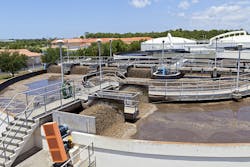Wastewater is now considered a beneficial asset for municipalities rather than a liability to be treated and disposed of as it has been in the past. This idea was the focus of Dr. Joe Cotruvo’s Professor POU/POE article in the January issue of Water Technology.
Municipal wastewater treatment facilities, commonly called publicly owned treatment works (POTWs), convert highly contaminated sewage into safe, beneficial products and helps maintain the environment at the same time. Technology can convert wastewater into many valuable products ranging from oil biofuels to natural gas, nutrient-rich solids, biosolids for soil conditioning and even high-quality drinking water. The harmful contamination that must be removed from sewage includes pathogenic microbes, nutrients and chemicals including pharmaceuticals and hormones.
- Microbial contaminants. Pathogenic microorganisms end up in sewage in large quantities not just during disease outbreaks, but also routinely in smaller amounts from people who are not overtly infected. These include bacteria: coli, Salmonella and campylobacter; protozoa: Cryptosporidium, Giardiaand various amoebae; viruses: hepatitis, 72 types of enteroviruses, norovirus, rotavirus and adenovirus; and other pathogens.
- Chemical contaminants. The number of potential chemicals in sewage is almost limitless, but most are present in small quantities. Many natural products from food and source water are present in large amounts and contribute to the total organic carbon load. Disinfection byproducts from drinking water and sewage treatment can be discharged or generated on-site. Pharmaceutical or metabolic products and human hormones; industrial chemicals; and minerals could also be present. The greatest concerns arise with those that are not easily chemically converted or biodegradable because they will survive longer in the environment.
The principal nutrients are organic and inorganic nitrogen and phosphorus. These are components of all foods and come from life-sustaining cellular and protein metabolism and catabolism. Nitrogenous products can be found in the forms of ammonia, amines, nitrate, nitrite or more complex molecules.
Treatment
Sewage treatment accelerates natural chemical and biological processes that would have occurred in the environment after the sewage is released. The process chemistry, biology and engineering technology is more complex than drinking water treatment because the array of contaminants and other undesirables is so broad. Their concentrations are also greater than those in contaminated drinking water sources.
Wastewater treatment levels are generally categorized as preliminary, primary, advanced primary, secondary, nutrient removal, tertiary, advanced or full advanced. Each physical/biological treatment step removes microbial contaminants to a degree. A minimum of secondary treatment is required in all of the more than 16,000 POTWs in the U.S. Universal higher quality wastewater treatment in the country has been introduced over more than 60 years and was ultimately driven by the 1972 amendments to the federal Clean Water Act.
Disinfection can be applied at multiple stages to control septic odors, kill microorganisms or provide oxidative effects. The effects could include colloid conversion to improve settling rate and removal by filtration.
Converting wastewater into safe products is essential before allowing the environment and humans to be exposed to it. The principal human health concern with municipal wastewater will always be pathogenic microorganisms, but environmental consequences of excessive discharges of sewage that has not been adequately treated also exist. Multiple technologies and configurations are available and in use, and research continues to improve the processes and reduce unit costs.
You can find the entire article here.


